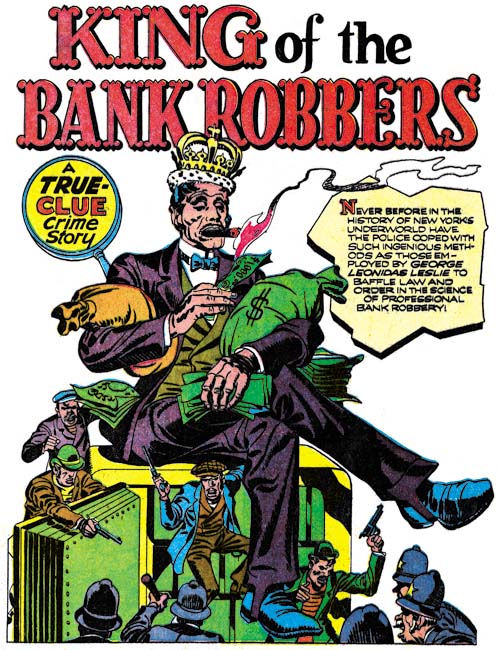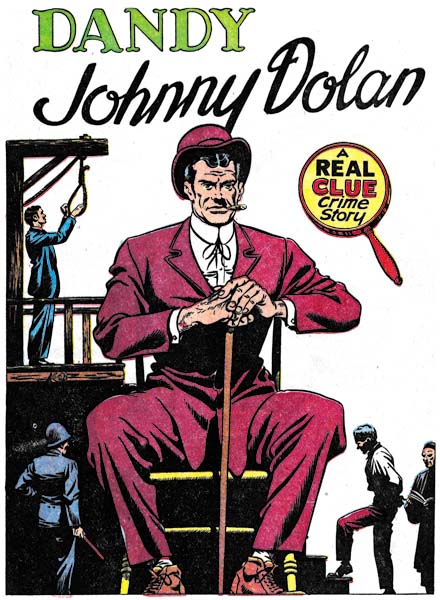Simon and Kirby crime tales, at least the earlier ones, were based on true stories. In a recent post I wrote about Simon and Kirby’s “Let Me Plan Your Murder” and the serial killer H. H. Holmes on which the story was based. I noted differences between the story which Joe and Jack presented and the facts that can be found on the Internet. These differences could be explained either as “poetic license” or inaccurate sources. Unfortunately there is no way to decide between the two explanations without knowing the actual sources used by Simon and Kirby. I remember reading somewhere (but regrettably I am not sure where) that one of the books Simon and Kirby used was “The Gangs of New York” by Herbert Asbury (1928). The book covers New York’s criminal elements from 19th to the early 20th centuries. Apparently this book was quite popular as there were four printings in the first year alone.

Clue Comics vol. 2 no. 1 (March 1947) “King of the Bank Robbers”, pencils by Jack Kirby
One of Simon and Kirby’s first entries in the crime genre was “King of the Bank Robbers” which was about George Leonidas Leslie. The same title was used for Chapter 10 of Asbury’s TGoNY. Asbury’s presentation pretty much matches the story depicted by Simon and Kirby. The main difference between the two takes is that Asbury went into more details than Simon and Kirby. However Joe and Jack embellished the facts to make it more of a story.

Real Clue Crime Stories vol. 2 no. 5 (July 1947) “The Terrible Whyos”, pencils and inks by Jack Kirby
Another example of a story taken from TGoNY was “The Terrible Whyos”. Without Asbury’s book a reader might doubt the accuracy of some of the things presented by Simon and Kirby. For instance in the story of perspective new member to the gang being rejected because he had not killed anyone. This might seem like an exaggeration but according to Asbury:
It has been said that during their period of greatest renown the captains of the Whyos would accept no man as a member until he had committed a murder, or at least had man an honest effort to thus enroll himself among the aristocracy of the underworld.
At one point Pike Ryan presents a poster showing the business rates, that is what to charge for commissioned crime ranging from blackening eyes to “da big sleep”. In the book Ashbury describes how when arrested Pike Ryan was found to have just a list and while the wording is not identical the rates were just as Simon and Kirby provided.

Real Clue Crime Stories vol. 2 no. 4 (June 1947) “Dandy Johnny Dolan”, art by unidentified artist
Simon and Kirby where not the only ones making use of Ashbury’s TGoNY. “Dandy Johnny Dolan” had no involvement from Simon and Kirby. While it just does not have the Simon and Kirby magic touch, it still is a rather nicely written and drawn story. But once again the events found in the story match what Ashbury presents in TGoNY, particularly how a cane Dolan took off one of his victims lead to being arrested for the crime.
All the comic book artists that used “The Gangs of New York” took liberties with the facts presented by Ashbury. In some case just to make a better story but in other cases because the true facts might be a little bit too much even in those pre-Comic Code days. Simon and Kirby might present some woman as a gangster’s girl friend but in reality she might have been a prostitute (and the criminal a pimp).
Even today “The Gangs of New York” is an enjoyable read. I understand it was reprinted about the same time as the movie of the same name came out. Ashbury does have a peculiar take on gangsters. As he tells it the gangs were all a thing of the past:
for there are now no gangs in New York, and no gangsters in the sense that the word has come into common use
It is hard to understand what Ashbury’s use of the word gangsters was if it excluded organized crime of his day. “The Gangs of New York” was published in 1927 about eight years after prohibition came into effect with the Eighteenth Amendment of the Constitution. Trade in illegal booze provided an abundant criminal income which propelled organized crime to great strength. Ashbury may have been blind to the new gangster, but the crime comics, including Simon and Kirby, were not.

